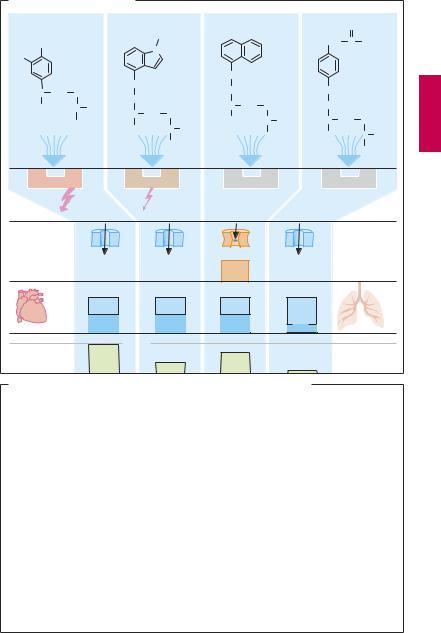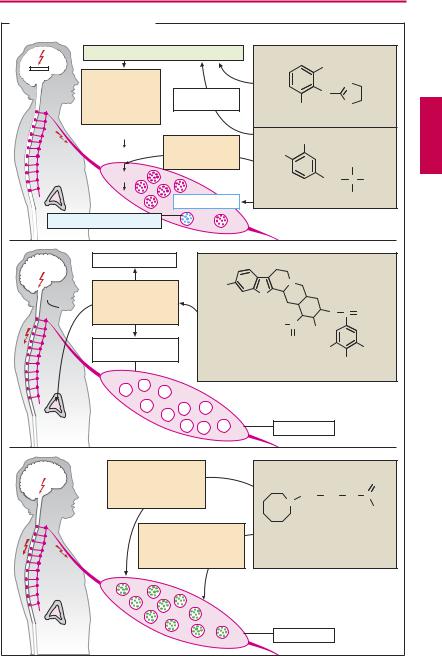
- •Preface to the 3rd edition
- •General Pharmacology
- •Systems Pharmacology
- •Therapy of Selected Diseases
- •Subject Index
- •Abbreviations
- •General Pharmacology
- •History of Pharmacology
- •Drug and Active Principle
- •The Aims of Isolating Active Principles
- •European Plants as Sources of Effective Medicines
- •Drug Development
- •Congeneric Drugs and Name Diversity
- •Oral Dosage Forms
- •Drug Administration by Inhalation
- •Dermatological Agents
- •From Application to Distribution in the Body
- •Potential Targets of Drug Action
- •External Barriers of the Body
- •Blood–Tissue Barriers
- •Membrane Permeation
- •Binding to Plasma Proteins
- •The Liver as an Excretory Organ
- •Biotransformation of Drugs
- •Drug Metabolism by Cytochrome P450
- •The Kidney as an Excretory Organ
- •Presystemic Elimination
- •Drug Concentration in the Body as a Function of Time—First Order (Exponential) Rate Processes
- •Time Course of Drug Concentration in Plasma
- •Time Course of Drug Plasma Levels during Repeated Dosing (A)
- •Time Course of Drug Plasma Levels during Irregular Intake (B)
- •Accumulation: Dose, Dose Interval, and Plasma Level Fluctuation (A)
- •Dose–Response Relationship
- •Concentration–Effect Curves (B)
- •Concentration–Binding Curves
- •Types of Binding Forces
- •Agonists—Antagonists
- •Other Forms of Antagonism
- •Enantioselectivity of Drug Action
- •Receptor Types
- •Undesirable Drug Effects, Side Effects
- •Drug Allergy
- •Cutaneous Reactions
- •Drug Toxicity in Pregnancy and Lactation
- •Pharmacogenetics
- •Placebo (A)
- •Systems Pharmacology
- •Sympathetic Nervous System
- •Structure of the Sympathetic Nervous System
- •Adrenergic Synapse
- •Adrenoceptor Subtypes and Catecholamine Actions
- •Smooth Muscle Effects
- •Cardiostimulation
- •Metabolic Effects
- •Structure–Activity Relationships of Sympathomimetics
- •Indirect Sympathomimetics
- •Types of
- •Antiadrenergics
- •Parasympathetic Nervous System
- •Cholinergic Synapse
- •Parasympathomimetics
- •Parasympatholytics
- •Actions of Nicotine
- •Localization of Nicotinic ACh Receptors
- •Effects of Nicotine on Body Function
- •Aids for Smoking Cessation
- •Consequences of Tobacco Smoking
- •Dopamine
- •Histamine Effects and Their Pharmacological Properties
- •Serotonin
- •Vasodilators—Overview
- •Organic Nitrates
- •Calcium Antagonists
- •ACE Inhibitors
- •Drugs Used to Influence Smooth Muscle Organs
- •Cardiac Drugs
- •Cardiac Glycosides
- •Antiarrhythmic Drugs
- •Iron Compounds
- •Prophylaxis and Therapy of Thromboses
- •Possibilities for Interference (B)
- •Heparin (A)
- •Hirudin and Derivatives (B)
- •Fibrinolytics
- •Intra-arterial Thrombus Formation (A)
- •Formation, Activation, and Aggregation of Platelets (B)
- •Inhibitors of Platelet Aggregation (A)
- •Presystemic Effect of ASA
- •Plasma Volume Expanders
- •Lipid-lowering Agents
- •Diuretics—An Overview
- •NaCl Reabsorption in the Kidney (A)
- •Aquaporins (AQP)
- •Osmotic Diuretics (B)
- •Diuretics of the Sulfonamide Type
- •Potassium-sparing Diuretics (A)
- •Vasopressin and Derivatives (B)
- •Drugs for Gastric and Duodenal Ulcers
- •Laxatives
- •Antidiarrheal Agents
- •Drugs Affecting Motor Function
- •Muscle Relaxants
- •Nondepolarizing Muscle Relaxants
- •Depolarizing Muscle Relaxants
- •Antiparkinsonian Drugs
- •Antiepileptics
- •Pain Mechanisms and Pathways
- •Eicosanoids
- •Antipyretic Analgesics
- •Nonsteroidal Anti-inflammatory Drugs (NSAIDs)
- •Cyclooxygenase (COX) Inhibitors
- •Local Anesthetics
- •Opioid Analgesics—Morphine Type
- •General Anesthesia and General Anesthetic Drugs
- •Inhalational Anesthetics
- •Injectable Anesthetics
- •Sedatives, Hypnotics
- •Benzodiazepines
- •Pharmacokinetics of Benzodiazepines
- •Therapy of Depressive Illness
- •Mania
- •Therapy of Schizophrenia
- •Psychotomimetics (Psychedelics, Hallucinogens)
- •Hypothalamic and Hypophyseal Hormones
- •Thyroid Hormone Therapy
- •Glucocorticoid Therapy
- •Follicular Growth and Ovulation, Estrogen and Progestin Production
- •Oral Contraceptives
- •Antiestrogen and Antiprogestin Active Principles
- •Aromatase Inhibitors
- •Insulin Formulations
- •Treatment of Insulin-dependent Diabetes Mellitus
- •Treatment of Maturity-Onset (Type II) Diabetes Mellitus
- •Oral Antidiabetics
- •Drugs for Maintaining Calcium Homeostasis
- •Drugs for Treating Bacterial Infections
- •Inhibitors of Cell Wall Synthesis
- •Inhibitors of Tetrahydrofolate Synthesis
- •Inhibitors of DNA Function
- •Inhibitors of Protein Synthesis
- •Drugs for Treating Mycobacterial Infections
- •Drugs Used in the Treatment of Fungal Infections
- •Chemotherapy of Viral Infections
- •Drugs for the Treatment of AIDS
- •Drugs for Treating Endoparasitic and Ectoparasitic Infestations
- •Antimalarials
- •Other Tropical Diseases
- •Chemotherapy of Malignant Tumors
- •Targeting of Antineoplastic Drug Action (A)
- •Mechanisms of Resistance to Cytostatics (B)
- •Inhibition of Immune Responses
- •Antidotes and Treatment of Poisonings
- •Therapy of Selected Diseases
- •Hypertension
- •Angina Pectoris
- •Antianginal Drugs
- •Acute Coronary Syndrome— Myocardial Infarction
- •Congestive Heart Failure
- •Hypotension
- •Gout
- •Obesity—Sequelae and Therapeutic Approaches
- •Osteoporosis
- •Rheumatoid Arthritis
- •Migraine
- •Common Cold
- •Bronchial Asthma
- •Emesis
- •Alcohol Abuse
- •Local Treatment of Glaucoma
- •Further Reading
- •Further Reading
- •Picture Credits
- •Drug Indexes

98 Drugs Acting on the Sympathetic Nervous System
Types of β-Blockers
The basic structure shared by most β-sym- patholytics (p.11) is the side chain of β-sym- pathomimetics (cf. isoproterenol with the β- blockers propranolol, pindolol, atenolol). As a rule, this basic structure is linked to an aromatic nucleus by a methylene and oxygen bridge. The side chain C-atom bearing the hydroxyl group forms the chiral center. With some exceptions (e.g., timolol, penbutolol), all β-sympatholytics exist as racemates (p.62).
Compared with the dextrorotatory form, the levorotatory enantiomer possesses a greater than 100-fold higher af nity for the β-receptor, and is, therefore, practically alone in contributing to the β-blocking effect of the racemate. The side chain and substituents on the amino group critically affect affinity for β-receptors, whereas the aromatic nucleus determines whether the compound possesses intrinsic sympathomimetic activity (ISA), that is, acts as a partial agonist or partial antagonist. A partial agonism or antagonism is present when the intrinsic activity of a drug is so small that, even with full occupancy of all available receptors, the effect obtained is only a fraction of that elicited by a full agonist. In the presence of a partialagonist (e.g., pindolol), the abilityofa full agonist (e.g., isoprenaline) to elicit a maximal effect would be attenuated, because binding of the full agonist is impeded. Partialagoniststhusalsoactantagonistically, although they maintain a certain degree of receptor stimulation. It remains an open question whether ISA confers a therapeutic advantage on a β-blocker. At any rate, patients with congestive heart failure should be treated with β-blockers devoid of ISA.
As cationic amphiphilic drugs, β-blockers can exert a membrane-stabilizing effect, as evidenced by the ability of the more lipophilic congeners to inhibit Na+ channel function and impulse conduction in cardiac tissues. At the usual therapeutic dosage, the
high concentration required for these effects will not be reached.
Some β-sympatholytics possess higher affinity for cardiac β1-receptors than for β2- receptors and thus display cardioselectivity (e.g., metoprolol, acebutolol, atenolol, bisoprolol, β1 : β2 selectivity 20–50-fold). None of these blockers is suf ciently selective to permit use in patients with bronchial asthma or diabetes mellitus (p.96).
The chemical structure of β-blockers also determines their pharmacokinetic properties. Except for hydrophilic representatives (atenolol), β-sympatholytics are completely absorbed from the intestines and subsequently undergo presystemic elimination to a major extent (A).
All the above differences are of little clinical importance. The abundance of commercially available congeners would thus appear all the more curious (B). Propranolol was the first β-blocker to be introduced into therapy in 1965. Thirty years later, about 20 different congeners were marketed in different countries (analogue preparations). This questionable development is unfortunately typical of any drug group that combines therapeutic with commercial success, in addition to having a relatively fixed active structure. Variation of the molecule will create a new patentable chemical, not necessarilya drug with a novel action. Moreover, a drug no longer protected by patent is offered as a generic by different manufacturers under dozens of different proprietary names. Propranolol alone has been marketed in 2003 by 12 manufacturers in Germany under nine different names. In the USA, the drug is at present offered by ~ 40 manufacturers, mostly under its generic designation, and in Canada by six manufacturers, mostly under a hyphenated brand name containing its INN with a prefix.
Luellmann, Color Atlas of Pharmacology © 2005 Thieme
All rights reserved. Usage subject to terms and conditions of license.

Types of β-Blockers |
99 |
A. Types of β -sympatholytics |
|
|
|
|
|
|
|
|
|
|
|
|||
Isoproterenol |
|
|
Pindolol |
H |
|
Propranolol |
|
Atenolol |
O |
|
||||
OH |
|
|
|
|
|
|
|
|
|
CH2 |
C |
NH2 |
||
|
|
|
|
N |
|
|
|
|
|
|
||||
HO |
|
|
|
|
|
|
|
|
|
|
|
|
|
|
|
|
|
|
|
|
|
|
|
|
|
|
|
|
|
|
|
|
O |
|
|
|
|
O |
|
|
|
|
|
|
HC CH2 |
+ |
|
|
|
|
|
CH2 |
|
|
O |
|
|
||
NH2 |
CH2 |
|
|
|
+ |
|
|
|
||||||
|
|
|
|
|
|
|
|
|
CH2 |
|
|
|||
OH |
HC |
CH3 |
HC |
CH2 |
+ |
|
HC |
CH2 |
NH2 |
|
+ |
|||
|
|
|
NH2 |
OH |
|
HC |
CH3 |
HC CH2 |
||||||
|
CH3 |
OH |
|
|
HC |
CH3 |
|
NH2 |
||||||
|
|
|
|
|
|
|
|
|
|
|||||
|
|
|
|
|
|
|
CH3 |
OH |
|
HC CH3 |
||||
|
|
|
|
|
|
CH3 |
|
|
|
|||||
|
|
|
|
|
|
|
|
|
|
|
|
CH3 |
||
|
|
|
|
|
|
|
|
|
|
|
|
|
|
|
|
β -Receptor |
|
|
β |
-Receptor |
|
|
β -Receptor |
|
|
||||
Agonist |
|
|
|
|
partial |
|
Antagonist |
Antagonist |
||||||
|
Effect |
|
|
Agonist |
|
|
|
No effect |
|
|
||||
|
|
|
|
|
|
|
|
|
|
|
||||
Sodium channel |
|
|
|
|
|
|
|
|
|
|
blockade |
|||
|
|
Na+ |
|
|
Na+ |
|
|
|
Na+ |
|
|
|
||
“membrane |
|
|
|
|
|
|
|
|
|
|
stabilizing” |
|||
β 1 |
|
β 1 |
|
|
β 1 |
|
β 1 |
|
|
β 1 |
|
|
β 2 |
|
Cardio- |
β |
2 |
|
|
β 2 |
|
β 2 |
|
|
β 2 |
selectivity |
|||
|
|
|
100% |
|
|
|
|
|
|
|
|
|
|
|
Presystemic |
|
50% |
|
|
|
|
|
|
|
|
elimination |
|||
B. Avalanche-like increase in commercially available β -sympatholytics
1965 |
1970 |
|
|
Year introduced |
Tertatolol |
Nebivolol |
|
|
|
|
|
|
|
|
Carvedilol |
|
|
|
|
|
|
|
|
Esmolol |
|
|
|
|
|
|
|
|
Bopindolol |
|
|
|
|
|
|
|
|
Bisoprolol |
|
|
|
|
|
|
|
|
Celiprolol |
|
|
|
|
|
|
|
Betaxolol |
|
|
|
|
|
|
|
|
Befunolol |
|
|
|
|
|
|
|
|
Carteolol |
|
|
|
|
|
|
|
Mepindolol |
|
|
|
|
|
|
|
|
Penbutolol |
|
|
|
|
|
|
|
|
Carazolol |
|
|
|
|
|
|
|
|
Nadolol |
|
|
|
|
|
|
|
|
Acebutolol |
|
|
|
|
|
|
|
|
Bunitrolol* |
|
|
|
|
|
|
|
|
Atenolol |
|
|
|
|
|
|
|
|
Metipranol |
|
|
|
|
|
|
|
Metoprolol |
|
|
|
|
|
|
|
|
Timolol |
|
|
|
|
|
|
|
Sotalol |
|
|
|
|
||
|
|
Talinolol |
|
|
|
|
||
|
|
Oxprenolol |
*No longer available commercially |
As of 2000 |
|
|||
|
|
Pindolol |
|
|
||||
|
|
|
|
|
|
|
|
|
|
Bupranolol* |
|
|
|
|
|
|
|
|
Alprenolol |
|
|
|
|
|
|
|
Propranolol |
1975 |
|
1980 |
1985 |
1990 |
1995 |
2000 |
|
Luellmann, Color Atlas of Pharmacology © 2005 Thieme
All rights reserved. Usage subject to terms and conditions of license.

100 Drugs Acting on the Sympathetic Nervous System
Antiadrenergics
Antiadrenergics are drugs capable of lowering transmitter output from sympathetic neurons, i.e., the “sympathetic tone.” Their action is hypotensive (indication: hypertension, p.314); however, being poorly tolerated, they enjoy only limited therapeutic use.
Clonidine is an α2-agonist whose high lipophilicity (dichlorophenyl ring) permits rapid penetration through the blood–brain barrier. The activation of postsynaptic α2-re- ceptors dampens the activity of vasomotor neurons in the medulla oblongata, resulting in a resetting of systemic arterial pressure at a lower level. In addition, activation of presynaptic α2-receptors in the periphery (pp.86, 94) leads to a decreased release of both norepinephrine (NE) and acetylcholine. Beside its main use as an antihypertensive, clonidine is also employed to manage withdrawal reactions in subjects being treated for opioid addiction.
Side effects. Lassitude, dry mouth; rebound hypertension after abrupt cessation of clonidine therapy.
Methyldopa (dopa = dihydroxyphenylal- anine), being an amino acid, is transported across the blood–brain barrier, decarboxylated in the brain to α-methyldopamine, and then hydroxylated to α-methyl-NE. The decarboxylation of methyldopa competes for a portion of the available enzymatic activity so that the rate of conversion of L-dopa to NE (via dopamine) is decreased. The false transmitter α-methyl-NE can be stored; however, unlike the endogenous mediator, it has a higher af nity for α2- than for α1-receptors and therefore produces effects similar to those of clonidine. The same events take place in peripheral adrenergic neurons.
Adverse effects. Fatigue, orthostatic hypotension, extrapyramidal Parkinson-like symptoms (p.188), cutaneous reactions, hepaticdamage,immune-hemolyticanemia.
Reserpine, an alkaloid from the climbing shrub Rauwolfia serpentina (native to the
Indian subcontinent), abolishes the vesicular storage of biogenic amines (NE, dopamine [DA], serotonin [5-HT]) by inhibiting the (nonselective) vesicular monoamine transporter located in the membrane of storage vesicles. Since the monoamines are not taken up into vesicles, they become subject to catabolism by MAO; the amount of NE released per nerve impulse is decreased. To a lesser degree, release of epinephrine from the adrenal medulla is also impaired. At higher doses, there is irreversible damage to storage vesicles (“pharmacological sympathectomy”), days to weeks being required for their re-synthesis. Reserpine readily enters the brain, where it also impairsvesicular storage of biogenic amines.
Adverse effects. Disorders of extrapyramidal motor function with development of pseudo-parkinsonism (p.188), sedation, depression, stuffy nose, impaired libido, impotence; and increased appetite.
Guanethidine possesses high af nity for the axolemmal and vesicular amine transporters. It is stored instead of NE, but is unable to mimic functions of the latter. In addition, it stabilizes the axonal membrane, thereby impeding the propagation of impulses into the sympathetic nerve terminals. Storage and release of epinephrine from the adrenal medulla are not affected, owing to the absence of a reuptake process. The drug does not cross the blood–brain barrier.
Adverse effects. Cardiovascular crises are a possible risk: emotional stress of the patient may cause sympathoadrenal activation with epinephrine release from the adrenal medulla. The resulting rise in blood pressure can be all the more marked as persistent depression of sympathetic nerve activity induces supersensitivity of effector organs to circulating catecholamines.
Luellmann, Color Atlas of Pharmacology © 2005 Thieme
All rights reserved. Usage subject to terms and conditions of license.

|
|
|
|
Antiadrenergics |
101 |
||
A. Inhibitors of sympathetic tone |
|
|
|
|
|
||
|
|
Stimulation of central α 2-receptors |
|
|
|
|
|
|
|
Suppression |
|
|
Cl |
|
|
|
|
|
|
|
N |
|
|
|
|
of sympathetic |
|
|
|
|
|
|
|
α -Methyl-NA |
|
N |
|
|
|
|
|
impulses in |
|
|
|
||
|
|
vasomotor |
in brain |
Cl |
H |
N |
|
|
|
center |
|
Clonidine |
|
H |
|
|
|
|
|
|
|
||
|
|
Tyrosine |
Inhibition |
OH |
|
|
|
|
|
|
|
|
|
||
|
|
DOPA |
of DOPA- |
HO |
|
|
|
|
|
|
decarboxylase |
|
|
CH3 |
|
|
|
Dopamine |
|
|
CH2 |
α |
NH2 |
|
|
|
|
|
C |
||
|
|
NA |
α -Methyl-NA |
α -Methyldopa |
|
COOH |
|
|
|
|
|
|
|
||
|
False transmitter |
|
|
|
|
|
|
NA |
|
CNS |
|
|
|
|
|
5HT |
|
|
|
|
|
|
|
DA |
|
|
N |
|
|
|
|
|
|
H3CO |
|
|
|
||
|
|
Inhibition of |
|
|
|
||
|
|
N |
|
|
|
||
|
|
|
|
|
|
||
|
|
biogenic amine |
|
|
|
|
|
|
|
|
H |
|
|
|
|
|
|
storage |
|
|
O |
C |
O |
|
|
|
|
H3CO C |
|
|
|
|
|
|
|
OCH3 |
|
|
|
|
|
Peripheral |
|
O |
|
|
|
|
|
|
H3CO |
|
OCH3 |
||
|
|
sympathetic activity |
|
||||
|
|
|
|
OCH3 |
|||
|
|
|
|
|
|
||
|
|
|
Reserpine |
|
|
|
|
No epinephrine from |
|
Varicosity |
|
|
|||
adrenal medulla |
|
|
|
|
|||
|
|
|
|
|
|
||
|
|
Inhibition of impulse |
|
|
|
|
|
|
|
propagation in |
|
|
|
NH |
|
|
|
peripheral sympathetic |
CH2 |
CH2 |
NH |
C |
|
|
|
nerves |
|
||||
|
|
|
|
N |
|
|
NH2 |
|
|
|
|
|
|
|
|
|
|
|
Active uptake and |
|
|
|
|
|
|
|
storage instead of |
|
|
|
|
|
|
|
norepinephrine; |
|
|
|
|
|
|
|
not a transmitter |
Guanethidine |
|
|
|
Release from adrenal medulla |
|
Varicosity |
|
|
|||
unaffected |
|
|
|
|
|||
|
|
|
|
|
|
||
Luellmann, Color Atlas of Pharmacology © 2005 Thieme
All rights reserved. Usage subject to terms and conditions of license.
